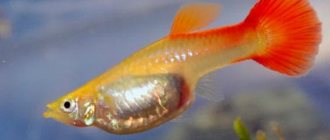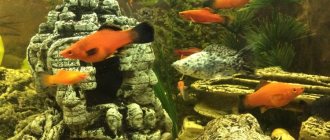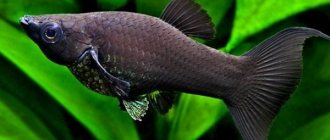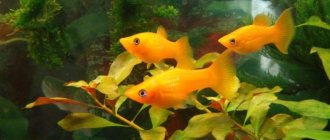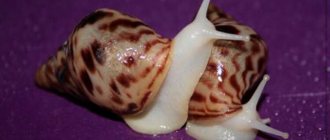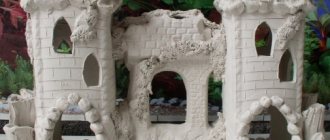Ancistrus are ray-finned fish that are the most popular aquarium inhabitants. They are unpretentious and behave quite peacefully, coexisting with the vast majority of the inhabitants. The structure of their oral cavity is specific, reminiscent of a suction cup with a scraper. This is why they are called “stickers” and “cleaners.” Fish can actually stick to the walls of the aquarium and remove growing unwanted vegetation.
History of appearance and domestication
Ancistrus were first discovered in America. Back in the middle of the 19th century, the domestication of these fish began. By 2005, there were already more than 50 species. Some of them can become a real decoration for your aquarium. In Russia they began to be bred only in the 70s of the last century. Today we’ll talk about the reproduction of these fish and raising young animals. Even an experienced aquarist does not always know what to feed ancistrus fry.
Manufacturer training
As already mentioned, Ancistrus catfish is a fish that is widely found in many freshwater aquariums in our country and abroad. And this fish can readily reproduce even in a general aquarium, without any hint of creating special conditions for spawning.
At the age of 7 to 10 months, most ancistrus become sexually mature. The exception is some species in which the young mature by 2 years.
By the time the fish are ready to bear fruit and reproduce, sexual differences are already visible to the naked eye. So-called tentacles grow on the male’s head. These are skin processes in the form of roots that grow both down and up from the male’s head. They are located over the entire area of the head and can reach one and a half centimeters in length. The older the male gets, the more branched his beard will be.
In a female, similar vegetation on the head may be completely absent, or small tentacles, no longer than 1 millimeter, may be located at the edges of the head.
Ancistrus, the reproduction of which was observed by studying the vegetation on the head of the male, and the mating behavior of loricariids in principle, scientists from the Academy of Natural Sciences of Philadelphia made some conclusions based on their research:
- The male can guard and care for several broods at the same time.
- When choosing a male, the one who is already guarding one brood has a better chance. Females perceive this as the male’s reproductive success and his viability as a parent.
- The antennae on the head of males are very reminiscent of the movement of catfish larvae. For the female, this can act as a signal, letting her know that this male has already proven himself to be a good parent and will be a good and reliable sexual partner.
Such options are possible in a species aquarium, or when several pairs are sent to spawn at once. In addition, it is important to talk about nutrition before such an important event.
Advantages and disadvantages
If you are interested in these bright fish, it means that sooner or later young animals will appear in your aquarium. You need to prepare for this event in advance. Knowing what to feed ancistrus fry at home, you will avoid common mistakes and the death of fish. Experienced aquarists note the pros and cons of breeding these fish:
- The advantages include ease of breeding and care, originality of appearance.
- But there are also certain disadvantages that you also need to know. They eat a lot. That is, you will have to clean the aquarium very often, and the filter will need to be quite serious. Another drawback is that these fish are difficult to catch from the aquarium. They instantly raise their fins and become entangled in the nets.
Motherland
Ancistrus stellata was first described in detail in early 1836 by Valansis. Catfish have been found in tributaries of the Amazon River. Especially in the Parana River. For a long time, the fish was known under a different name. But time passed and the catfish began to be assigned numbers. In this case, the star ancistrus was assigned the number L181. It is worth noting that this species is not included in the Red Book.
The first thing everyone notices is the unusual color. Black body with snow-white specks and the same edging on the fins. This color is associated with the starry sky. The mouth resembles a suction cup; with its help, catfish clean off plaque that forms on plants, stones, and snags. The white edging on the fins and tail disappears as they grow older.
Average sizes range from 8 to 10 cm. The character is peaceful. However, conflicts can occur with males of their kind. In an aquarium, a strong male is often able to kill a young and weak one. Ancistrus are not interested in other types of fish. Most of the time they are in cover. They are active at night.
Catfish feeding
As a rule, hobbyists do not care too much about what these entertaining fish will eat. It is believed that they will make do with the leftovers from the feast of other fish. Because of this, the catfish get sick and do not grow to their normal size.
- Ancistrus need animal food in small quantities. But if you overfeed them with bloodworms, the fish will suffer from bloating and may die.
- Chopped carrots and broccoli. They can be pricked with forks and put into the aquarium. Then they will not float up and will be eaten by fish.
- Up to 80% of the diet should consist of plant foods.
Ancistrus species
Let's describe just a few of them:
Regular (Blue)
The main color tones range from grayish-yellow and blue to dark gray. May have a white border on the dorsal and caudal fins. The length of an adult is up to 15 cm.
Red
It has a brick-red, almost orange, coloring. The length of an adult is up to 6 cm.
Albino
The main color is yellow or pale yellow, the eyes are red. The length of an adult is up to 8 cm.
Star-shaped
It is almost black in color with many white dots. The head and body are somewhat wider than those of the closest species relative, Ancistrus vulgaris. The length of an adult is up to 8-10 cm.
Diet before spawning
If you decide to seriously engage in breeding catfish, then you need to know what fish eat during the mating season, as well as what to feed the Ancistrus fry. Individuals that are preparing for spawning should be sent to a separate aquarium. It is necessary to increase the protein portion of the diet to 50%. It is preferable to feed your fish frozen live food. A plant-based diet should include bell peppers, cucumber and asparagus, pumpkin and zucchini. A good result is obtained by introducing sea fish into the diet. If you decide to start breeding for the first time, then you need to study in advance the question of what to feed the Ancistrus fry, so as not to kill the babies.
Breeding at home
You can determine the sex of ancistrus by its head and the presence of mustaches
How to distinguish a female from a male
Determining the sex of ancistrus is quite easy, but this can only be done after the fish have reached sexual maturity, which occurs in the second year of life. At this time, skin growths (whiskers) are formed in males on the upper jaw, reaching 2 centimeters in length, while in females they are absent. At the same time, the body of the female is larger, longer and slender, and their fins are longer and sharper than those of the males.
Reproduction of Ancistrus
The male ancistrus takes on the role of parent and cares for the eggs throughout the entire maturation period
Ancistrus become sexually mature in the second year of development. After this, they can spawn up to five to six times a year. They can breed independently in a community aquarium.
If breeding is carried out purposefully, then the selected male and female need to be separated. For this you can use a small spawning aquarium (40 l). It must be equipped with driftwood, as well as shelters in which the eggs will be laid. A filtration and aeration system is also necessary. It is recommended to treat the water with methylene blue, which will help eliminate fungal flora.
You can identify a pregnant female by her “puffiness.” After this, preparation for spawning begins, and then the process itself:
- The male very actively searches for the place where laying will take place, and then thoroughly cleans it.
- Over the course of a week, the female lays 30–100 small yellow, orange or pink eggs at night.
- The eggs are attached in clusters to the walls of the prepared shelter.
- At the end of the clutch, the male performs fertilization and drives the female out of the home. After this, it must be sent to a general aquarium.
- The male takes care of the offspring of Ancistrus. He supplies oxygen to the clutch, fanning it with his fins, and removes non-viable eggs.
- During the ripening of eggs, you should not attract the attention of the male; if he panics, he can destroy the clutch.
- In good conditions, the larvae emerge within five days and feed on the gallbladder's reserves. When they run out, the larvae turn into fry.
Fry
The fry appear approximately two weeks after laying. During this period, they are fed live dust, ciliates, artemia nauplii, rotifers, microworms, crushed spirulina tablets, carefully crushed egg yolks and cucumbers. In the first month of development, food should be six times a day; subsequently, the fry are fed three times a day. After one and a half months from the moment of appearance, they can be moved to a common aquarium.
Problems with reproduction
With proper care and arrangement of the aquarium, problems with the reproduction of ancistrus do not arise. But if spawning does not occur for a long time, then it is recommended:
- change most of the water in the aquarium;
- increase the temperature;
- increase the amount of protein feed in the diet;
- Install cuttings of PVC pipes in the aquarium, in which fish like to breed.
Spawning
The success of breeding depends largely on the choice of producers. The aquarist must select them in such a way that the female is larger than the male. This ensures the success of the entire event. Transplanted into the spawning area, they begin to establish the place. Moreover, it is mostly the male who is doing this. He carefully cleans the chosen place and stays nearby. Soon a female swims into the maternity hospital, and its walls are decorated with orange eggs.
Then the male does all the work. It fertilizes the eggs and protects the clutch. From this point on, the female must be removed because the male may kill her. At this stage, it creates a current of water with rhythmic movements of its fins. He removes dead eggs from the nest, monitors the general condition of the clutch and protects it from any attacks. At this time, it is necessary to minimize all interference in the life of the underwater world. While you are removing the remains of vegetables, the suspicious male will receive extreme stress, worrying about his offspring.
Differences between females and males
This section will mainly write about the differences between males and females of the star ancistrus. This is due to the fact that among Ancistrus vulgaris there are no serious differences between the sexes. So, at approximately the age of 12-15 months, fish of this species reach sexual maturity. The male's head is more flattened on top.
At about 3-5 months, anciks grow two mustaches on their lips, and these mustaches are not an indicator of gender. Subsequently, females retain these antennae, but males begin to grow branched horns on the entire upper surface of the head.
Start
Appearance of fry
From the first day you need to think about what to feed the Ancistrus fry. The day is not far off when tiny catfish will begin to feed on their own. Their clutch is relatively small, it can contain from 20 to 100 eggs. After about a week, the larvae appear, and after another 48 hours the crumbs begin to scrape off food. From this moment their conscious life begins. The male has fulfilled his role, he is caught and sent to a common aquarium. Now high-quality feeding is the key to good growth of young animals.
Compatibility with other fish
Although not a predator, Ancistrus has a very peaceful character. And although some of its species are quite large, it is impossible to keep these catfish with large and medium-sized predators. However, even some medium-sized predatory fish will not be able to cause serious harm to catfish, due to the presence of a dense bony shell and spines on the pectoral fins.
The most accommodating neighbors will be the fish of most non-predatory species of aquarium multi-colored fish of the characin, cyprinidae, macropod and poeciliaceae families: Norman's blue-eye; Neon; Mollies; Swordtails; Danio.
Bad neighbors can be: Cichlids; Cockerels.
Starter feed
Usually it is at this stage that novice aquarists begin to call their more experienced colleagues and ask what to feed the fry of Ancistrus catfish. For the first few days they will not swim to food. The starting food for young animals will be dry fish food and fresh vegetables. Usually, already on the third or fourth day, the tiny creatures begin to be interested in the cucumber. This is the biggest treat for them.
Feeding Ancistrus fry is quite simple. You need to prick a piece of vegetable on a fork and lower it into the aquarium. As they grow older, it is very important to move the fry to larger quarters. An important step is placing driftwood in the aquarium. The cellulose that the fish scrape off is very important for intestinal function.
Content
Ancistrus catfish in an aquarium does not require special conditions. But he also needs some care. The water temperature should be stable, within +25C. Unacceptably increased content of nitrogenous compounds and phosphates in water. pH and kH indicators should not exceed 7 units.
Soft, slightly acidic water is considered optimal for this type of fish. Such indicators correspond to the Amazonian biotope, the natural habitat of ancistrus. In this case, the level of nitrites, nitrates and ammonia should be monitored.
For a comfortable life for a pair of catfish, a container of 80 - 100 liters is required. The bottom should definitely be equipped with various shelters (grottoes, caves, dense thickets, snags), where the fish can hide during daylight hours, using them as houses. The presence of cellulose in water is mandatory. Therefore, a snag or stump made of natural wood will not only be a beautiful decorative element, but also a functional component of the biological system of a reservoir.
Mandatory conditions for keeping ancistrus are aeration and water filtration. A more powerful filter is chosen to simulate flow.
Despite the fact that catfish are able to maintain cleanliness in the aquarium, they need to change some of the water weekly.
Bright light creates a feeling of discomfort in the ancistrus. A large amount of algae will well shade the space of the reservoir. It is not worth planting them in the ground: in search of food, catfish actively dig it up, tearing out plants with their roots. It's better to plant them in pots.
When catfish grow up
If you want your fish to grow healthy and live a long time, then it is best to pay attention to professional food. Food for Ancistrus fry from TM Tettra and Sera allows you to provide the body with everything necessary. These companies have been at the top of the quality level of animal food products for many years and offer super premium food.
In addition, you can feed Ancistrus fry frozen brine shrimp. Try not to overfeed. They will eat food as much as they can see. If you give brine shrimp to other inhabitants, calculate the amount so that the catfish have very little left.
And finally, vegetables. They should be in the diet constantly. Don't let leftover food rot at the bottom. Therefore, you need to regularly remove vegetables and replace them with fresh ones. The food for Ancistrus fry must be crushed. Chopped carrots and broccoli are firm enough and don't create a cloudiness, but kids won't be able to eat them. Spinach, lettuce, zucchini and white cabbage will be very useful. The fry eat pumpkin very well; it is quite soft and contains a large amount of vitamins and minerals.
Future maternity hospital
If you have planned spawning of ancistrus, then you will need to prepare a container where you will place your producers. For one pair of producers, you can choose an aquarium from 50 liters. If you plan to plant 1 male and 2 females for spawning, then it is advisable to take a slightly larger container.
For a spawning aquarium, the presence of soil and plants is not an urgent need. The most important thing is a shelter in which the eggs will be laid, and a shelter for the female. After the eggs are laid, the male will drive the female away and will no longer allow her to approach the clutch. The male's aggression is quite high in this phase, and if the female does not have shelter, she may die under the pressure of a zealous defender of the clutch. It is advisable to remove the mother after the eggs have left the mother.
The tube in which it is most convenient for ancistrus to lay eggs should be opaque and blank on one side. The length of such a tube should be 1.5 times the length of the male’s body, and the width should allow the male to swim inside with his fins fully extended.
Reviews
The star anchistruss is a funny and cute neat creature. Such a catfish will become a real decoration of the aquarium and will bring perfect cleanliness. It removes plaque well that appears on plants, glass, and decorations. Very beautiful, it’s a pity that he leads a nocturnal lifestyle. Anton Samokhin, 47 years old, Moscow
For those who love ancistrus, I advise you to add L181 to your collection. It feels like a piece of the night sky surrounded by stars is floating in an aquarium. Interesting color, especially the edging on the fins (it disappears with age). If you plan to breed, it is better to keep it in an aquarium without other ancistrus, otherwise they may interbreed. Tatyana Ivanova, 32 years old, Penza
Habitat
Under natural conditions, ancistrus are found mainly in South America, mainly in the mountain tributaries of the Amazon in the Peruvian part of the Andes, as well as in the upper reaches of the Orinoco River in Venezuela. Ancistrus was presumably brought to Russia in the 1970s.
In the wild, this fish lives in fast-flowing, shallow mountain streams. This is due to the absence of a swim bladder and the presence of a powerful oral sucker, which makes it easy to stay on the rocks even in strong currents, as well as a strong shell that protects against objects that the current can carry.
